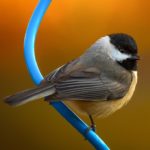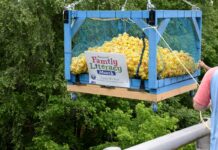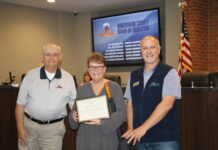
The migration of hummingbirds has begun. Although most of the flock, also referred to as a bouquet, a glittering, a hover, a shimmer, or a tune, is still around south Georgia and the Gulf coast area, some have already been spotted in Gainesville, Atlanta, and Chattanooga. Have you seen a hummer yet in your neighborhood?
Here is an interactive migration map you can use to track their flight progress:
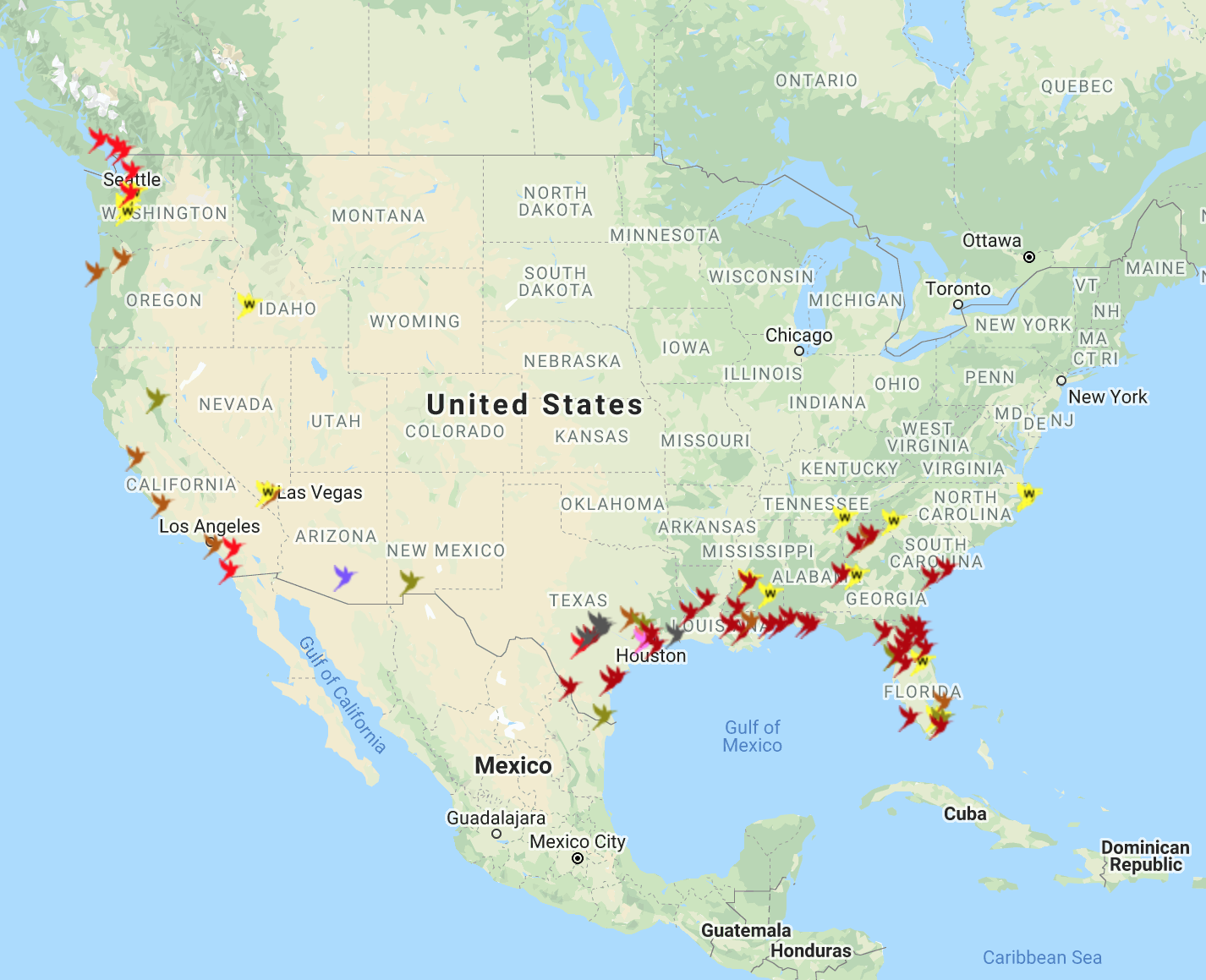
Most hummingbirds spend the winter in Central America or Mexico and migrate north to their breeding grounds in the southern United States as early as February, and to areas further north later in the spring.

Hummingbirds fly by day and fly low allowing the birds to see, and stop at, food supplies along the way. They are also experts at using tailwinds to help reach their destination faster and by consuming less energy and body fat. Research indicates a hummingbird can travel as much as 23 miles in one day.
During migration, a hummingbird’s heart beats up to 1,260 times a minute, and its wings flap 15 to 80 times a second. To support this high energy level, a hummingbird will typically gain 25-40% of their body weight before they start migration in order to make the long trek over land and water.
Feed the hummingbirds and they’ll return the favor
This is where you and I come in. If you want to make sure they visit your yard, feed them. There is not much blooming right now so fill up those feeders and make sure you follow the right recipe.
Ingredients:
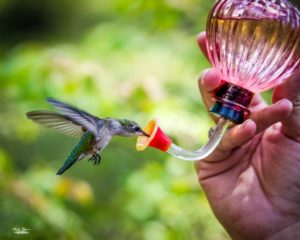
- Refined white sugar
- Water
Directions for making safe hummingbird food:
- Mix 1 part sugar with 4 parts water (for example, 1 cup of sugar with 4 cups of water) until the sugar is dissolved. Let cool.
- Do not add red dye.
- Fill your hummingbird feeders with sugar water and place them outside.
- Extra sugar water can be stored in your refrigerator.
When spring turns to summer and the temperatures heat up, you’ll need to change out the nectar after two to three days.
Fun Facts about hummers
- Hummingbirds have no sense of smell but can hear much better than humans.
- Hummingbirds are attracted to all bright colors, although red is most commonly associated with these tiny birds.
- Hummingbirds see in ultraviolet light and they can see further than a human.

- Hummingbirds have a great memory – they remember every flower & feeder they’ve been to, and how long it will take a flower to refill.
- Their brains make up 4.2% of their body weight. Proportionally speaking, they have the largest brains of the wild bird group.
- Hummingbirds are the only birds that can fly up, down, sideways, forward, and backward!
- Hummingbirds are the second largest family of birds with more than 300 species.
- Their average lifespan is 5 years, but they have been known to live for more than 10 years.
Photography 101
When the hummers are starting to visit you might want to take their picture and that requires patience and a little know-how.

Marty Barr is a professional photographer. He sort of fell into photography by accident. His wife, Jennifer, has been a professional horseshow photographer for more than 20 years. One night at a horse show, she needed his help. He picked up a camera for the first time and never looked back.
“I studied seven days a week about photography. I read everything I could get my hands on and it became an obsession to teach myself and learn to be the best I could be. I also learned there is a big difference between taking a picture and taking a photograph, like drawing a straight line with a ruler or painting a Van Gogh,” Marty says.
According to Jennifer, Marty is a natural.
“He has an artistic eye and a strong work ethic. He worked day after day tracking/timing birds during rain, cold, sun, didn’t matter, and to learn the tracking and timing of horse gaits and rhythms. Since I had the advantage of my mom being a photographer, I learned in the show ring and never did much wildlife photography until a few years ago. His eye is his advantage. I’ve never seen someone take to photography as he did and work as hard as he did to be where he is now,” Jennifer explained.
The challenge of hummingbirds
What started with horse show photography led to traveling to farms across the country and observing, not only horses but other wildlife in the countryside. During that time Marty developed a love for capturing birds and other wildlife through his lens.
“Bird photography is just something I love, especially hummingbirds because they are so hard to photograph. They are tiny and never still in the air unless they’re perched.”
Apparently, it takes practice, and lots and lots of patience to get it right. Marty started practicing bird photography in the backyard of his home, eight hours a day, five or six days a week, for about two years, before he mastered the art.
“You can’t make an animal or bird do what you want. You are on their time and you have to focus on one feeder and one bird at a time, especially in capturing hummingbird pictures.”
Marty not only pre-plans for taking bird photos but he and Jennifer both put a lot of effort into how to get the very best pictures.

“Jennifer plants the flowers they love, we hang several feeders, and then I wait because it requires a lot of patience. If you are taking pictures of a hummingbird, the patience is worth every minute because the lighting on the bird and colors that are enhanced are truly amazing.”
Marty says a point-and-shoot camera will work for capturing those shots but you have to use a manual setting because the camera is not smart but the operator can be. If you don’t adjust the shutter speed to a minimum of 1200 you will get motion blur every time.
“I use a 150-450mm Pentax K1 Mark II camera with a 150-450mm lens. It’s a heavy lens and because of the time involved in getting the perfect shot, I recommend a good tripod because you have to keep steady and focus on one feeder and one bird,” he explained.
Bottom line, most of us are going to be taking pictures with a point-and-shoot which can work on a manual setting. For professional quality, the investment is going to run about $700 to $800. It all depends on your level of interest and commitment.
Calling all birds
The love for taking pictures of all God’s creatures from the smallest of birds, the hummingbirds, didn’t stop there. Marty and Jennifer began to learn about all birds which they might attract to their backyard. They now have about 20 species who visit regularly including towhees, starlings, finches, woodpeckers, cardinals, bluebirds, juncos, cowbirds, wrens, chickadees, and thrashers. Besides the “regulars”, about two new species of birds visit their yard every year.
If it sounds like a bird sanctuary it probably is. The feeders they place in their yard are filled with wild bird seed mix, suet, sunflower seeds, thistle seeds, occasionally mealworms, and, of course, nectar for the hummingbirds.
As a gardener, Jennifer is the one who plants the flowers which attract the hummers and other birds. She recommends weigela, tall garden phlox, bee balm, salvia, butterfly bush, and yarrow. The hummingbirds especially nip from the red, yellow, orange, pink, and purple blooms.
Let us know when you see your first hummer and if you try your hand at taking their picture. You don’t have to be a professional. Who knows, you may develop a frame-worthy picture and a passion. Hummers are so beautiful, they really oughta be in pictures!
You can follow Barr Studios at https://barrstudios.com/ and on Facebook @barrstudios.





